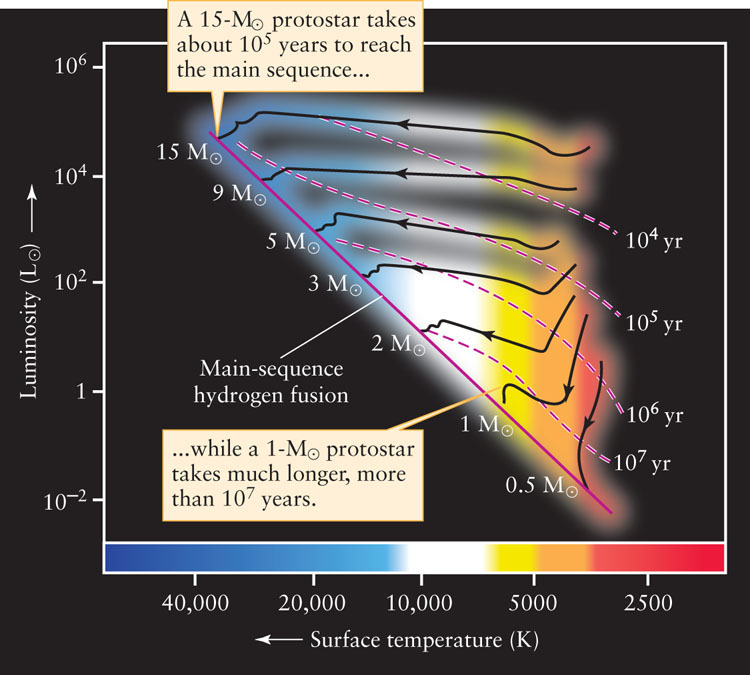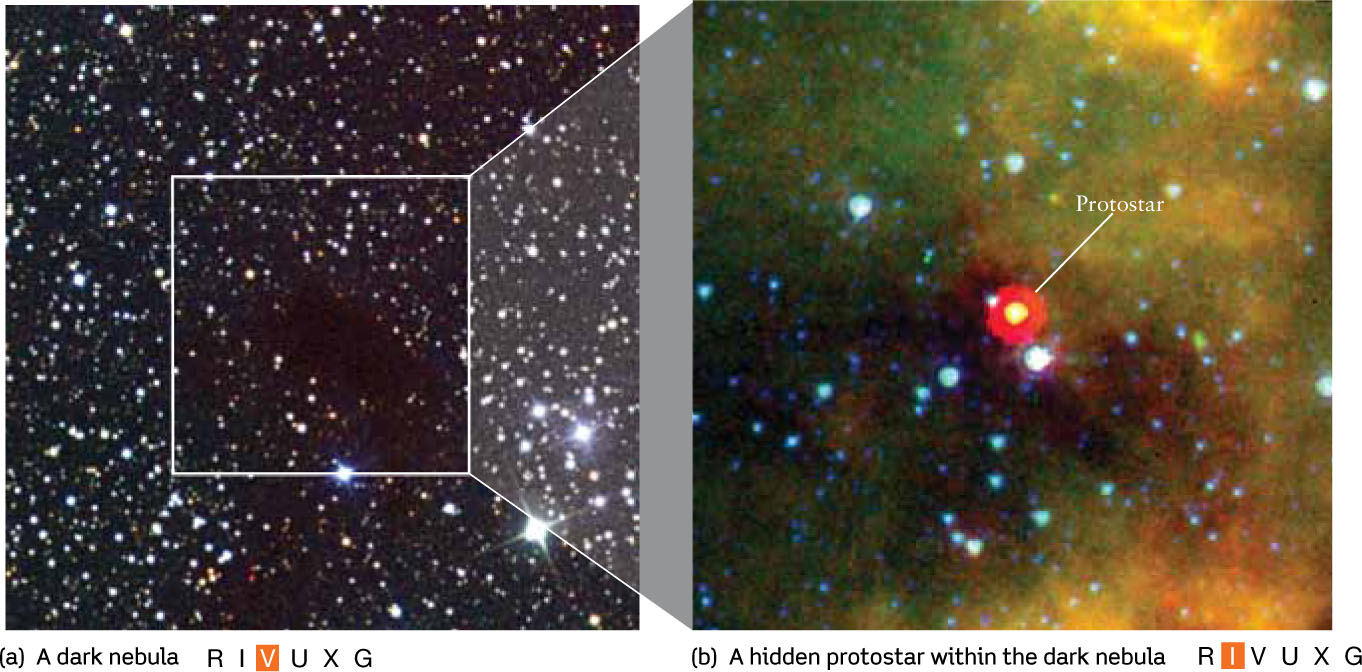18-3 Protostars form in cold, dark nebulae
 How do stars form in the interstellar medium? In this section, we discuss how a contracting cloud gives birth to a clump called a protostar—a future main-sequence star.
How do stars form in the interstellar medium? In this section, we discuss how a contracting cloud gives birth to a clump called a protostar—a future main-sequence star.
Protostars: Initial Gravitational Collapse

Bok Globules The dark blobs in this photograph of a glowing H II region are clouds of dust and gas called Bok globules. A typical Bok globule is a parsec or less in size and contains from one to a thousand solar masses of material. The Bok globules and H II region in this image are part of a much larger star-forming region called NGC 281, which lies about 2900 pc (9500 ly) from Earth in the constellation Cassiopeia. The image shows an area about 2.7 pc (8.8 ly) across.
In order for interstellar material to condense and form a star, the force of gravity—which tends to draw interstellar material together—must overwhelm the internal pressure pushing the material apart. This means that stars will most easily form in regions where the interstellar material is relatively dense, so that atoms and dust grains are close together and gravitational attraction is enhanced.
To assist star formation, the pressure of the interstellar medium should be relatively low. This means that the star-forming region of the interstellar medium should be as cold as possible, because the pressure of a gas goes down as the gas temperature decreases. (Conversely, increasing the temperature of a gas makes the pressure increase. For example, the air pressure increases inside a covered pot of boiling water, which often causes steam to shoot out.)
In the first stage of star formation, a protostar coalesces and contracts due to the mutual gravitational attraction of its parts
The only parts of the interstellar medium with high enough density and low enough temperature for stars to form are the dark nebulae. Many of these nebulae, such as the Horsehead Nebula (see Figure 18-2) and Barnard 86 (see Figure 18-4), were discovered and catalogued around 1900 by Edward Barnard and are known as Barnard objects. (The Horsehead Nebula is also known as Barnard 33.) Other relatively small, nearly spherical dark nebulae are known as Bok globules, after the Dutch-American astronomer Bart Bok, who first called attention to them during the 1940s (Figure 18-9). A Bok globule resembles the inner core of a Barnard object with the outer, less dense portions stripped away. The density of the gas and dust within a Barnard object or a Bok globule is indeed quite high by cosmic standards, in the range from 100 to 10,000 particles per cm3; by comparison, most of the interstellar medium contains only 0.1 to 20 particles per cm3. Radio emissions from molecules within these clouds indicate that their internal temperatures are very low, only about 10 K.
A typical Barnard object contains a few thousand solar masses of gas and dust spread over a volume roughly 10 pc (30 ly) across; a typical Bok globule is about one-tenth as large. The chemical composition of this material is the standard “cosmic abundance” of about 74% (by mass) hydrogen, 25% helium, and 1% heavier elements (review Figure 8-4). Within these clouds, the densest portions can contract under their own mutual gravitational attraction and form clumps called protostars. Each protostar will eventually evolve into a main-sequence star. Because dark nebulae contain many solar masses of material, it is possible for a large number of protostars to form out of a single such nebula. Thus, we can think of dark nebulae as “stellar nurseries.”
The Evolution of a Protostar
In the 1950s, astrophysicists such as Louis Henyey in the United States and C. Hayashi in Japan performed calculations that enabled them to describe the earliest stages of a protostar. At first, a protostar is merely a cool blob of gas several times larger than our solar system. The pressure inside the protostar is too low to support all this cool gas against the mutual gravitational attraction of its parts, and so the protostar collapses. As the protostar collapses, gravitational energy is converted into thermal energy, making the gases heat up and start glowing. (We discussed this process, called Kelvin-Helmholtz contraction, in Section 8-4 and Section 16-1.) Energy from the interior of the protostar is transported outward by convection, warming its surface.
After only a few thousand years of gravitational contraction, the protostar’s surface temperature reaches 2000 to 3000 K. At this point the protostar is still quite large, so its glowing gases produce substantial luminosity. (The greater a star’s radius and surface temperature, the greater its luminosity. You can review the details in Section 17-6 and Box 17-4.) For example, after only 1000 years of contraction, a protostar of 1 solar mass (1 M⊙) is 20 times larger in radius than the Sun and has 100 times the Sun’s luminosity. Unlike the Sun, however, the luminosity of a young protostar is not the result of thermonuclear fusion, because the protostar’s core is not yet hot enough for fusion reactions to begin. Instead, the radiated energy comes exclusively from the heating of the protostar as it contracts.
In order to determine the conditions inside a contracting protostar, astrophysicists use computers to solve equations similar to those used for calculating the structure of the Sun (see Section 16-2). The results tell how the protostar’s luminosity and surface temperature change at various stages in its contraction. This information, when plotted on a Hertzsprung-Russell diagram, provides a protostar’s evolutionary track. The track shows us how the protostar’s appearance changes because of changes in its interior. These theoretical tracks agree quite well with actual observations of protostars.
CAUTION!
When astronomers refer to a star “following an evolutionary track” or “moving on the H-R diagram,” they mean that the star’s luminosity, surface temperature, or both change. Hence, the point that represents the star on an H-R diagram changes its position. This change is completely unrelated to how the star physically moves through space!
Figure 18-10 shows evolutionary tracks for protostars of seven different masses, ranging from 0.5 M⊙ to 15 M⊙. Because protostars are relatively cool when they begin to shine at visible wavelengths, these tracks all begin near the right (low-temperature) side of the H-R diagram. The subsequent evolution is somewhat different, however, depending on the protostar’s mass. Note that the greater a star’s mass, the more rapidly it moves along its evolutionary track: a 15-M⊙ protostar takes only about 105 years to reach the main sequence, while a 1-M⊙ protostar takes over a hundred times longer (more than 107 years).

CONCEPT CHECK 18-3
Is it possible for a protostar to shine brighter than the main-sequence star it becomes?
Yes. The evolutionary track for a 1 M⊙ solar star like our Sun in Figure 18-10 indicates that such a protostar is almost 100 times more luminous when it forms then when it reaches the main sequence.
CONCEPT CHECK 18-4
About how long does it take for a 2-M⊙ protostar to reach the main sequence?
The red dashed lines indicate how long it takes for protostars to cross those lines on their way to the main sequence. A 2 M⊙ star reaches the main sequence after about 107 (10 ten million) years.
Observing Protostars
Observing the evolution of a protostar can be quite a challenge. Indeed, while Figure 18-10 shows that young protostars are much more luminous than the Sun, it is quite unlikely that you have ever seen a protostar shining in the night sky. The reason is that protostars form within clouds that contain substantial amounts of interstellar dust. The dust in a protostar’s immediate surroundings, called its cocoon nebula, absorbs the vast amounts of visible light emitted by the protostar and makes it very hard to detect using visible wavelengths.
Protostars can be seen, however, using infrared wavelengths. Because a cocoon nebula absorbs so much energy from the protostar that it surrounds, the nebula becomes heated to a few hundred kelvins. The warmed dust then reradiates its thermal energy at infrared wavelengths, to which the cocoon nebula is relatively transparent. So, by using infrared telescopes, astronomers can see protostars within the “stellar nursery” of a dark nebula.
Figure 18-11 shows visible-light and infrared views of one such stellar nursery. The visible-light view (Figure 18-11a) shows a dark, dusty nebula (or Bok globule) that appears completely opaque. The infrared image (Figure 18-11b) allows us to see through the dust, revealing a newly formed protostar within the dark nebula. The properties of this protostar agree well with the theoretical ideas outlined in this section.
